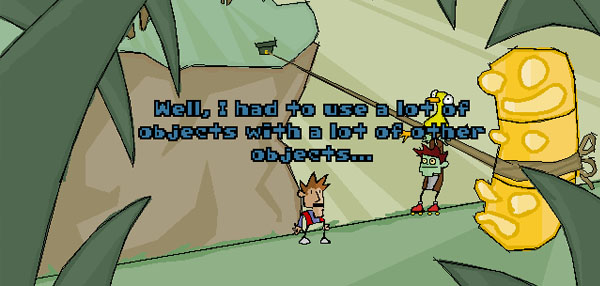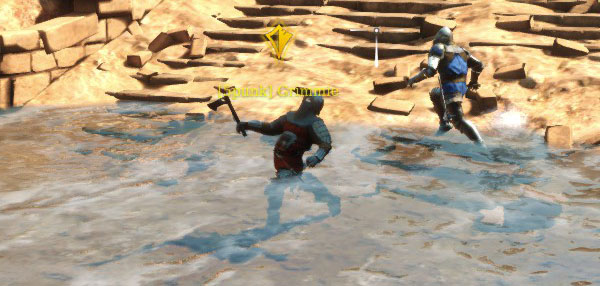Ben There, Dan That is and old school point-and-click adventure, similar to Lucasarts’ SCUMM based games from the 90s. For those too young to remember, SCUMM was the engine used to develop such classics as The Secret of Monkey Island, Sam & Max Hit the Road, and Day of the Tentacle. For those too young to remember those games, this could well be your gateway into a wealth of great and almost timeless games.
The posters on the wall in the screenshot above are telling references to the inspiration for Ben There, Dan That. The focus here is heavily on the humour, but it has a strong character of its own courtesy of the game’s titular characters, Ben and Dan. Much of the dialogue in the game is between the duo, a witty back and forth falling generally into the well tread comedy trope of straight man and funny man. The British developers upon whom the game’s characters are based also bring a dry slant to the comedy which is somewhat unique among its peers. That could well be a matter of taste, but it hit the right notes for me.
There’s more to a point-and-click than jokes though. Puzzles form the main challenge, and for the most part the desired result is well communicated. It isn’t flawless in that respect – I had to resort to an online guide on a couple of occasions – but for the most part the difficulty is in working out how to do something rather than what it was I needed to do. Those familiar with the genre will have undoubtedly reached a point in other games where you, in desperation, use each item in your inventory on the others in an attempt to find out some obscure combination. I won’t claim I didn’t to that here also, but I can declare that it didn’t work.
The story centres around Dan and Ben trying to get home after being abducted by aliens, which takes them through various alternate dimensions, each a warped version of Earth. It’s all very tongue-in-cheek, with alternatives such as a world where Britain is ruled by America, one where dinosaurs are still the dominant race, or the aftermath of a zombie apocalypse. All of this is rendered in low-fi 2D, and if beautifully painted mattes or complex 3D models are your thing then the doodle-esque art style may not be for you. The style fits the tone though, and while I expect something more detailed could well have added some nice incidental detail to the benefit of the game, the lack of it doesn’t detract. The sound is similarly basic but fitting, with cheerful and unintrusive chip music plinking away in the background.
Ben There, Dan That is the funniest point-and-click I’ve played since the early 90s. It’s not particularly long or difficult, and other modern adventures (Machinarium for example) can provide prettier backdrops and cleverer puzzles, but if you like your games with a sense of humour then this is the one to choose. And if you haven’t played those games I mentioned in the introduction, and you do play this and enjoy it, get yourself ScummVM and have a go at some of the old classics.











